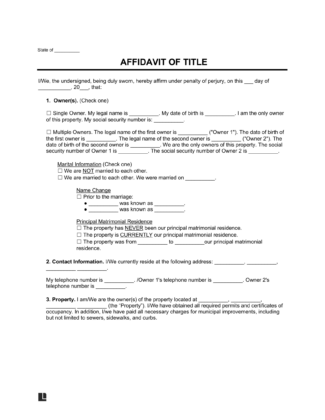
Use our affidavit of title to prove to buyers that you legally own the property you’re selling.

Updated September 26, 2023
Written by Josh Sainsbury | Reviewed by Susan Chai, Esq.
An affidavit of title is created by a property seller and designed to protect the buyer. It is a commonly used legal document in real estate purchase agreement transactions and other property transactions where ownership is transferred, and it does not distinguish between property types (such as a home, condominium, or a piece of land).
The affidavit of title contains a sworn statement where the seller of a piece of real estate swears that they hold the property’s title. In other words, it is legal proof that the seller owns the property and has the right to sell it to another person.
In the document, the seller makes several sworn statements, which include:
Real Estate Transactions: Affirm their ownership of the property and warrant that there are no undisclosed liens, judgments, or other claims against the title.
Mortgage or Loan Applications: Verify that the borrower has clear title to the property and that no known issues could affect the lender’s security interest in the property.
Title Insurance: Assess the risk associated with the title and determine whether to issue a title insurance policy.
Foreclosure Proceedings: Establish the lender’s ownership interest in the property and confirm that there are no other conflicting claims against the title.
Boundary Disputes or Property Claims: Present evidence of ownership and provide a sworn statement about the status of the title.
Follow the steps below to write an affidavit of title.
Provide the current property owner’s (seller’s) full name, date of birth, and social security. Indicate if there is a single owner or if there are multiple property owners. If there are multiple owners, provide the same information for each of them.
If there are multiple property owners, specify whether the owners are married to each other. If yes, provide the date of marriage, any prior names used (i.e., maiden names), and whether the property is or was the principal matrimonial residence.
Provide the owner’s address, including the street address, city, state, and zip code. Also, specify each owner’s telephone number.
Provide the full address (street, city, state, zip code) of the property subject to this affidavit.
Specify whether the property has had any additions or substantial improvements made. If yes, provide a description of the additions and/or improvements and the date those were performed.
Provide whether there are any liens or encumbrances against the property. If yes, mention the type of lien or encumbrance, whether it is a judgment, tax lien, etc., and provide a detailed description.
Specify whether there are any adverse tax claims against the property. If there are, provide a detailed description.
Provide whether the owner(s) has declared bankruptcy in the past. If yes, mention the date of bankruptcy and whether there are any outstanding claims from the bankruptcy.
Specify whether current tenants live on the property or any outstanding property leases. If yes, provide the date the lease will expire.
Below, you can find what an affidavit of title typically looks like.